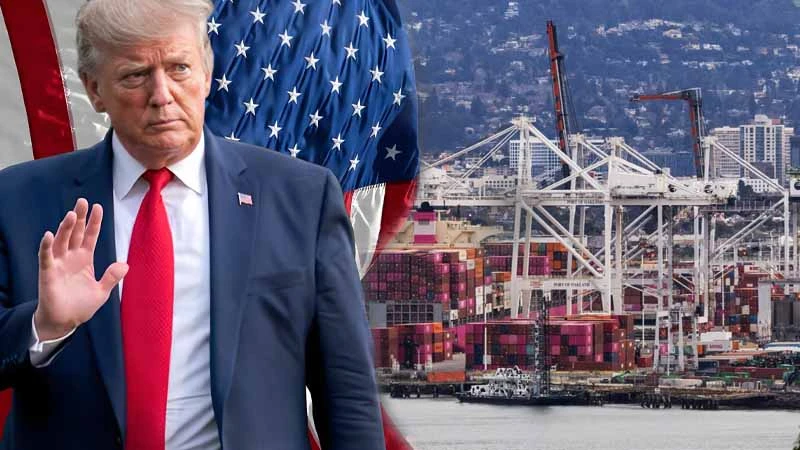The Hedging Equation in a Volatile Market: Examining Hong Kong Tech Stocks and REITs Allocation through the US Market Transmission Effect
2024 Q4 US Nasdaq Index plunged 3.6%, while the Hang Seng Tech Index fell 4.2% simultaneously, highlighting that the linkage between the two markets has deepened to the level of capital flows. Facing the Federal Reserve’s policy swings, the tech industry’s cyclical shifts, and rising geopolitical risks, Hong Kong stocks serve a dual role as a “buffer valve” against US bond shocks and an “α source” to capture structural opportunities. As of early 2025, southbound capital allocations to Hong Kong tech stocks and REITs surpassed 37%. Institutions are responding to normalized volatility with a “barbell strategy”—one end positioned on AI computing infrastructure, the other locked in high-dividend defensive REITs. This strategic migration is reshaping the risk-pricing logic of offshore markets.
Driving Factors of US Market Volatility and the Ripple Effect on Global Markets
Recent sharp volatility in the US stock market has become a weather vane for global capital markets. Since Q4 2024, the Federal Reserve’s monetary policy shift, earnings divergence among tech giants, and escalating geopolitical risks have constituted the three main drivers of market volatility. These factors are not only reshaping valuation logic in the US stock market but also exerting a “stress test” on Hong Kong stocks through cross-border capital flows and sentiment transmission. This section will analyze the underlying mechanisms of US market volatility and explore its spillover effects on the Hong Kong market.
The Federal Reserve’s Policy and the Tug-of-War over Rate Expectations
In December 2024, the Federal Reserve unexpectedly lowered its rate-cut forecast, reducing the anticipated annual rate cuts from 75 basis points to 50 basis points, causing a short-term surge in US Treasury yields. The 10-year Treasury yield briefly touched 4.8%, triggering a valuation correction in tech stocks. This move reflects the Federal Reserve’s concerns over “stagflation risks”—although breakthroughs in AI technology are driving productivity growth, the Trump administration’s expansionary fiscal policies (such as allocating hundreds of billions of dollars for disaster relief) and potential tariff measures (targeting China, Mexico,Canada and other countries) may exacerbate inflation stickiness. This policy uncertainty has forced investors to reprice risk assets, with the Nasdaq Index falling 3.6% in July 2024 alone, marking the largest monthly pullback since 2022.
Earnings Divergence and Sector Rotation in Tech Stocks
The earnings performance of tech giants has become a volatility amplifier for the market. For example, Tesla’s net profit fell 45% in Q2 2024, dragging the S&P 500 Index down 2.3% in a single day; in contrast, Microsoft and Amazon exceeded expectations in cloud business growth, supporting a countertrend rise in the communication services sector. This divergence highlights the “new and old momentum shift” within the tech industry: traditional hardware manufacturers are facing inventory destocking pressure, while AI computing power and data center operators are benefiting from the capital expenditure cycle. The sector rotation effect has further spread to Hong Kong stocks, with Hang Seng Tech Index constituents such as Alibaba-W, Xiaomi Corporation and others showing significantly higher volatility synchronization due to their business structures being closely tied to US tech leaders.
Resonance between Geopolitics and Market Sentiment
The Trump administration’s threat of “100% punitive tariffs” and political turmoil in France have intensified the global contraction of risk appetite. In December 2024, Chinese concept stocks fell for two consecutive months by 3.5%, reflecting investors’ pricing of China-US decoupling risks. Such events are pre-reflected through the “Hang Seng Index futures,” for instance, when the S&P 500 Index closes down 1%, Hang Seng Index futures often follow with a 0.8%-1.2% decline. This sentiment transmission mechanism positions Hong Kong stocks as both a “buffer cushion” and a “pressure release valve” for global political risks.
The Linkage Mechanism between Hong Kong Stocks and US Stocks: From Capital Flows to Sector Transmission
As an offshore market, the pricing logic of Hong Kong stocks has long been dominated by US dollar liquidity and risk sentiment. According to research by GF Securities, since 1991, the correlation coefficient between Hong Kong and US stocks has reached 0.769, and during rate hike cycles, the volatility of Hong Kong stocks is usually 1.2-1.5 times higher than that of US stocks. This section deconstructs the linkage paths between the two markets from a quantitative perspective, providing an empirical basis for subsequent hedging strategies.
The “Dual-Valve” Effect of US Dollar Liquidity
The Federal Reserve’s policy influences Hong Kong stocks through three channels:
- Interest spread-driven carry trades: When US Treasury yields are higher than Hong Kong Interbank Offered Rates, international capital tends to exit Hong Kong stocks and flow into US dollar assets. In December 2024, the US-Hong Kong interest rate spread widened to 250 basis points, causing southbound capital net inflows to plummet to HKD 4.297 billion.
- Exchange rate fluctuation balance sheet effect: About 60% of Hong Kong-listed companies’ revenue comes from mainland China. For every 1% depreciation of the RMB against the US dollar, the EPS of Hang Seng Index constituents is revised down by an average of 0.8%.
- Risk premium repricing: When US economic data falls short of expectations, for every 10-point increase in the VIX fear index, the price-to-earnings ratio of the Hang Seng Index is compressed by an average of 0.3 times.
Structural Characteristics of Sector Linkages
The tech and REITs sectors show differentiated linkage patterns:
- Tech stocks “follow the rise but not the fall”: When the Nasdaq Index rises, the correlation coefficient of the Hang Seng Tech Index through Stock Connect reaches 0.92; however, when US tech stocks correct, the downside correlation coefficient is only 0.65. This is because the median valuation of Hong Kong tech stocks (18x PE as of February 2025) offers a safety margin compared to US peers (35x PE).
- REITs “counter-cyclical hedging”: When the S&P 500 Volatility Index (VIX) breaks above 25, the average daily trading volume of Hong Kong’s Link REIT (00823.HK) surges by 40%, indicating that capital views it as a safe haven.
Time-Zone Differences and Expectation Management Function
Hong Kong’s night futures contracts and US after-hours trading form a “closed-loop of expectations.” For example, in January 2025, when the US tech sector rose 2% in after-hours trading, the Hang Seng Tech Index had a 78% probability of opening higher the next day. This mechanism positions Hong Kong stocks as an “Asian time-zone risk-hedging tool” for global investors.
The Dual Role of Tech Stocks: Volatility Source and Alpha Catcher
The Hong Kong tech sector showed strong resilience in early 2025, with the Hang Seng Tech Index rising 26%, ranking first among major global indices. Behind this phenomenon is not only support from improved industry fundamentals but also a revaluation of long-term growth logic by capital.
Valuation Restructuring under the AI Revolution
Breakthroughs in generative AI technology are driving divergence among Hong Kong tech stocks:
- Computing power layer: SMIC (00981.HK) saw a Q4 increase of HKD 8.76 billion in public fund holdings, reflecting market optimism about domestic AI chip substitution.
- Application layer: Kingdee International (00268.HK) reached a record high as its ERP system integrated AI assistants, pushing its customer renewal rate to 92%.
- Infrastructure layer: Data center operator GDS Holdings (09698.HK) benefited from REITs financing policy incentives, with its price-to-sales ratio recovering from 1.2x to 2.5x.
Policy Dividends and Improved Liquidity
The China Securities Regulatory Commission included REITs in Stock Connect, allowing tech infrastructure operators to directly raise low-cost funds. For example, the “Hang Seng Tech 30 ETF” (513160) saw its single-day turnover surge 10 times after the policy announcement, indicating accelerated institutional allocation to AI computing power assets. In addition, companies such as Xiaomi Corporation (01810.HK) increased buybacks (totaling HKD 12 billion in 2024), effectively offsetting the pressure of foreign capital outflows.
Hedging Logic of REITs: Rebalancing Low Volatility and High Dividends
The Hong Kong REITs market ushered in a structural turning point in 2025. Despite an average price-to-book ratio of only 0.36x, an 8.04% dividend yield and a 34.6% debt ratio make it a “ballast” in volatile market conditions.
Empirical Test of Inflation-Hedging Attributes
According to US market experience, REITs deliver an annualized return of 12.5% when CPI annual growth is in the 3%-5% range, significantly outperforming the S&P 500 Index’s 7.8%. Hong Kong’s Link REIT (00823.HK) recorded a 5.3% CAGR in dividend growth over the past five years, forming a safety cushion against Hong Kong’s inflation rate (2.8%).
Liquidity Improvement and Valuation Recovery
After being included in Stock Connect, the average daily turnover rate of REITs rose from 18.9% to 25.7%, with southbound capital holdings exceeding 5%. At the same time, the policy exempted stamp duty (previously 0.1%), reducing transaction costs by 30% and attracting increased allocations from insurance funds and pension funds.
Strategic Choices under Sector Linkages
Investors can allocate in layers according to risk preferences:
- Defensive type: Choose REITs with a debt ratio below 30% and rental income accounting for over 85%, such as Champion REIT (02778.HK).
- Growth type: Allocate to data center and logistics warehouse REITs, benefiting from AI computing power and the rise in e-commerce penetration. For example, SF REIT (02191.HK) recorded an 8.5% rental adjustment rate in the past six months.
Institutional Trends and Strategic Insights: Opportunities under Global Capital Rebalancing
In Q4 2024, active funds raised their allocation ratio to Hong Kong stocks to 14.3%, hitting a historical high. Capital flows reveal two major trends:
The “Barbell Strategy” of Tech and REITs
Institutions such as BlackRock adopt a “70% tech stocks + 30% REITs” portfolio, balancing growth and income. This strategy achieved an annualized volatility of 12.5% in H2 2024, lower than the 22.3% of pure tech portfolios.
The Rising Pricing Power of Southbound Capital
Southbound capital recorded 12 consecutive months of net inflows, totaling HKD 281.8 billion, with holdings in individual stocks such as Xiaomi and SMIC surpassing 10%, partially offsetting the selling pressure from foreign capital.
Conclusion: Finding Structural Anchors amid Volatility
Facing the normalization of high volatility in US stocks, Hong Kong stock investors need to pay more attention to the “asymmetry of risk-reward ratios.” The AI transformation of tech stocks and the liquidity dividend of REITs form the two pillars of the current market. A dynamic rebalancing strategy is recommended: when the VIX Index breaks above 30, increase the REITs allocation ratio to 40%; once market sentiment recovers, shift the focus back to the elasticity of tech stocks. This framework not only captures the dividends of industrial upgrading but also smooths portfolio volatility through high-dividend assets, gaining a first-mover advantage in global capital rebalancing.
Frequently Asked Questions
Q1: Why does US market volatility significantly impact Hong Kong stocks?
Key mechanisms: US dollar liquidity (US Treasury yield changes drive cross-border capital flows) + industry correlation (Hong Kong tech stocks’ business structures highly overlap with Nasdaq constituents) + sentiment transmission (Hong Kong night futures and US after-hours trading form a closed-loop of expectations). Empirical evidence shows that when the S&P 500 Volatility Index (VIX) rises by 10 points, the Hang Seng Index’s average opening volatility the next day expands by 1.8 times.
Q2: Why are Hong Kong tech stocks more resilient compared to US peers?
Core logic: Valuation safety margin (Hong Kong tech stocks’ 2025 forecast median PE 18x vs US 35x) + southbound capital support (cumulative net purchases of HKD 120 billion in tech stocks in 2024) + business model differences (Hong Kong focuses on AI computing infrastructure and other To B fields, less affected by consumer cycles).
Q3: How is the hedging advantage of REITs quantified in a high-interest-rate environment?
Data support: Taking Link REIT (00823.HK) as an example, with a debt ratio maintained at 32% and a dividend yield of 7.4%, when Hong Kong’s overall market volatility rises by 1 unit, the volatility of the REITs sector only increases by 0.3 units, showing significantly low correlation (β value 0.47).
Q4: How can individual investors implement the “tech stocks + REITs” barbell strategy?
Operational framework:
- Capital allocation: 70% in Hang Seng Tech Index ETFs (such as 03033.HK) + 30% in high-dividend REITs (such as Sunlight REIT 00435.HK)
- Rebalancing timing: Adjust the ratio to 60:40 when the VIX Index breaks above 30 or when the Hang Seng Index fluctuates more than 3% in a single day
- Risk control: Set a 10% stop-loss for the tech stock portion, while holding the REITs portion until one week before the ex-dividend date
Q5: How do geopolitical risks affect the effectiveness of the above strategy?
Scenario analysis:
- Escalation of China-US tensions: Tech stocks may face short-term pressure, but the logic of AI domestic substitution (such as SMIC) may benefit against the trend
- Sudden changes in China Hong Kong interest rate policy: If Hong Kong Interbank Offered Rates surge, investors need to avoid stocks with a debt ratio >45% as REITs’ financing costs increase
- RMB exchange rate fluctuations: Holding REITs with diversified revenue sources (such as data centers and cross-border logistics warehouses) can hedge single-currency risks
Related articles
-
Since 2025, global financial markets have continued to focus on the monetary policy trends of the US Federal Reserve (Fed) and movements in the US Dollar Index. As a barometer of the international market, the performance of the US Dollar Index (DXY) directly affects asset prices and capital flows in...2025 年 3 月 18 日
-
In February 2025, Donald Trump's 25% tariff on imported cars triggered an instant earthquake in the global supply chain. This trade policy, which has been labelled “America First 2.0", has not only forced multinational car companies to urgently reorganise production, it has also pushed the price of precious metals past...2025 年 2 月 21 日
-
On February 20, 2025, the Australian Bureau of Statistics released the latest data showing that, after seasonal adjustment, the unemployment rate rose from the previous month’s 4.0% to 4.1%. This marks the second consecutive monthly increase since hitting a historical low of 3.46% in October 2022. Although the trend unemployment...2025 年 2 月 21 日













